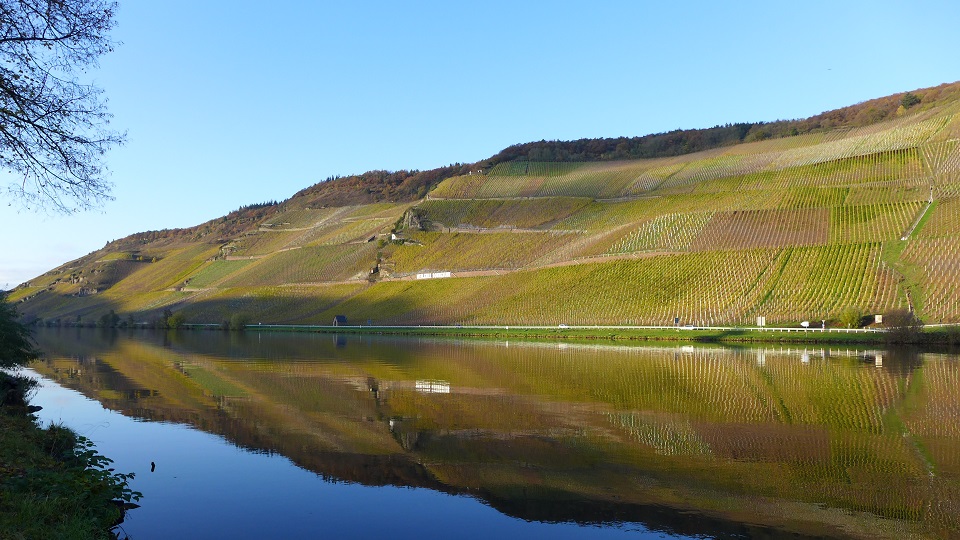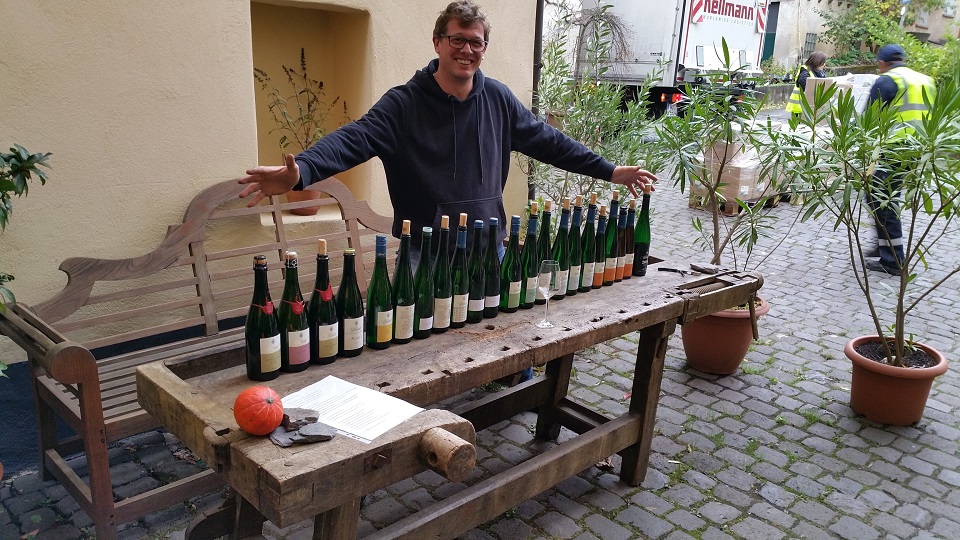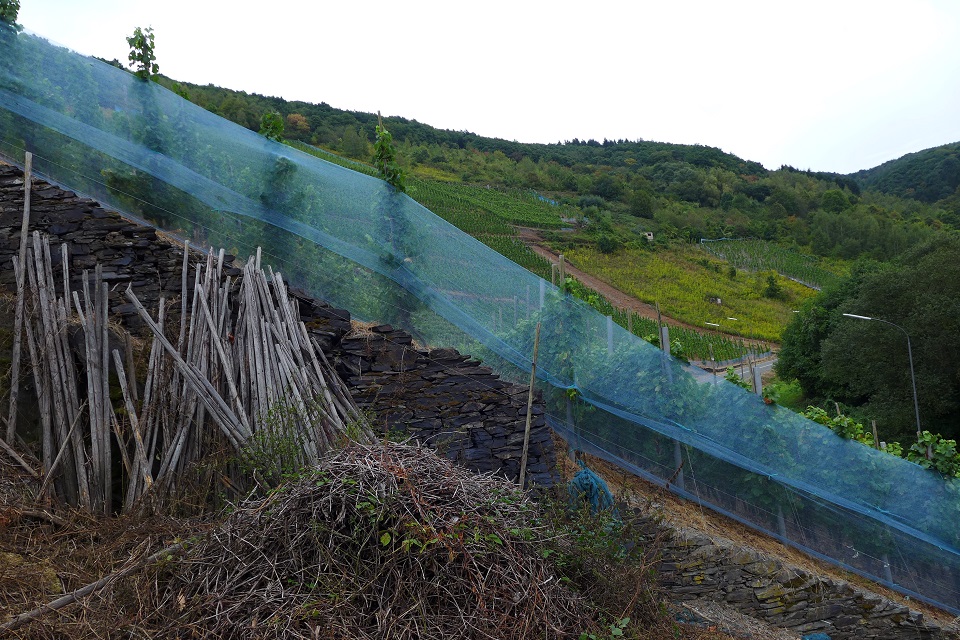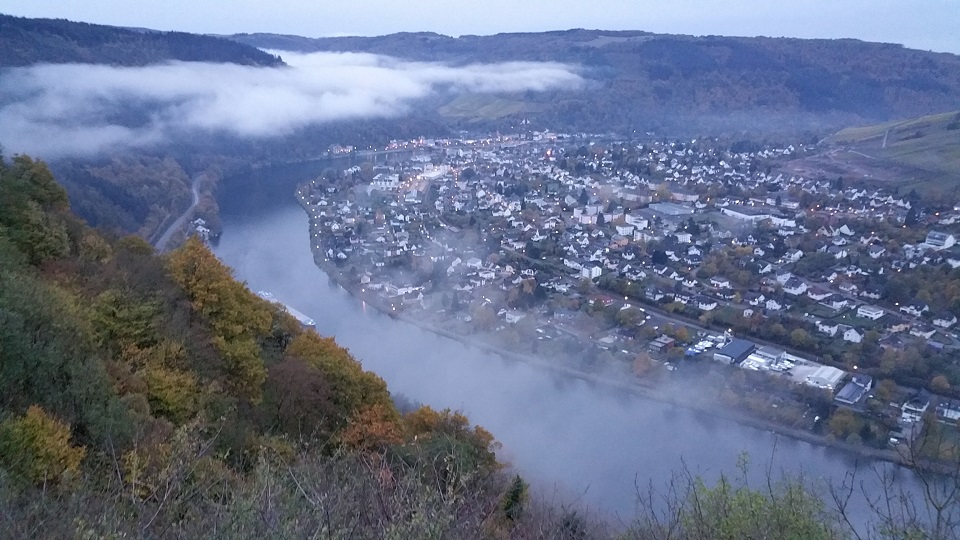Browse using the new Vinous website now. Launch →
Printed by, and for the sole use of . All rights reserved © 2015 Vinous Media
Multifarious 2017 Mosels, Part 1: Winningen to Wehlen
BY DAVID SCHILDKNECHT | JANUARY 23, 2020
The broad outlines of 2017 on the Mosel and Ruwer are already familiar from my earlier reports on Riesling Germany in this vintage. A turbocharged spring rendered vines vulnerable to the hard, widespread April 20 frost that was especially severe in many Mosel vineyards, killing up to half of the precocious buds. The weather then turned dry and warm, quickly compensating for any time the vines had lost in recovering from the shock of frost and setting the growing season back on the fast track. A midsummer drought and heat wave were broken by the arrival of rain at the end of July, and significant August precipitation was generally welcomed (though some sectors and growers reported that it triggered an irritating outbreak of powdery mildew). Unfortunately, in Graach and around Traben Trarbach, August 1 brought damaging hail.
Given a small crop in nearly all vineyards – even in sites spared by frost and hail, the set had been small to begin with – sugars began accumulating at a precocious and accelerating pace. By early September, most sites had received more than enough rain, but rain continued. Where frost and hail had taken an especially hard toll, the small number of bunches meant that if vines began pumping water, berries weren’t going to resist the pressure for long and would begin splitting. Where this happened, unwanted botrytis appeared early, although cool September temperatures helped limit its spread. Given high must weights and an already punishingly tiny crop threatened by rot, most Mosel growers set all-time records (though these would be shattered in 2018) by commencing their 2017 Riesling harvest in the third or fourth week of September. Many also set speed records – Stefan Justen spoke of a “head-over-heels harvest” – in order to minimize the threat from ignoble botrytis.

The equally iconic Wehlener Sonnenuhr and Weingut Joh. Jos. Prüm teamed up for some of 2017's most memorable Mosel Rieslings. Their offerings from adjacent Zeltinger Sonnenuhr and Graacher Himmelreich - as well as those of Markus Molitor - were no less stunning.
Caught Between Rot Risk and Hard Acidity
Acid levels in 2017 fruit remained high throughout harvest, but were naturally especially prominent where picking took place in September. As I have noted in several recent reports, it begins to look as though the phenomenon of high acidity in years that are nonetheless precociously ripe and feature hot summers correlates with vines having reacted to dry early spring weather by making metabolic adjustments conducive to drought tolerance. Of course, extreme drought stress can cause vines to shut down, which blocks both sugar accumulation and acid respiration. And shutdown was a factor in 2017 in at least some Mosel vineyards, notably ones with young vines. But the factors most conducive to high acid retention were the cool September temperatures and early picking dates. “If malic acidity is going to dissipate and total acid levels to drop, then it is going to happen in September,” observed Daniel Vollenweider, “and that is precisely when we got rain and cool weather in 2017.” High must weights with high acidity can be a welcome combination – “To me it’s the special liveliness [Lebendigkeit] of the acidity that constitutes this vintage’s most attractive feature,” avers veteran Dr. Loosen cellarmaster and vineyard manager Bernard Schug – but the combination is unwelcome if the acids are hard-edged and the grapes lack the desired aromatic and flavor evolution.
In the most problematic instances, what got picked early exhibits shrill acidity and borderline ripeness – especially if any bunches that originated with second budding after the frost were not left hanging for later – while what got picked later tastes significantly riper but not perfectly clean. Factors correlated with vine genetics, such as weight and looseness of clusters, were significant in determining how well the fruit resisted rain. But root depth – a function of vine age and viticultural practices – was certainly also significant, since shallow roots conduce to pumping water. Where things worked out well, ample ripeness is combined with bracing, even exhilarating acidity, and any botrytis that made it to the press house has had an ennobling effect. Depending on local conditions, growers’ intentions and the skill with which their crews were able to select, there are numerous nobly sweet Rieslings at many Mosel addresses, albeit in tiny quantities. Some of the vintage’s TBAs issued from musts so elevated in sugar that they were still fermenting their way toward legal vinosity when I returned in September 2019 to begin assessing wines of vintage 2018.

Biodynamic pioneer and stylistic maverick Thorsten Melsheimer showing an outstanding and, as usual, highly diverse collection at the end of October 2018, soon after many of them had been bottled.
Harnessing Versus Handling
The grower’s greatest ally in harnessing the positive potential of 2017 acidity was this vintage’s freakishly high levels of sugar-free dry extract, which largely take the form of acid-buffering potassium. As I have discussed previously, this phenomenon seems initially hard to square with a hot, dry midsummer, and even sites that were spared frost or hail and had a decent set and normal yields featured extreme dry extract. It seems that, like acid retention, extract is most influenced by conditions in late summer, and there was evidently plenty of solids-depositing water coursing through Mosel vines in September 2017. Extract levels this abnormally high often exercise a curious influence on picking decisions, conditioned as many growers are to monitoring Oechsle levels, because measurements on that scale are not strictly of sugar in the grape must but rather of its density. Off-the-charts sugar-free dry extract contributes significantly to must density, so that the stock of fermentable sugar proves less than a given Oechsle reading would normally lead one to expect. Had they taken this factor into consideration, some growers would no doubt have tried to hold out a bit longer before commencing harvest, and some professed eventual surprise at lower-than-anticipated alcohol levels in their dry wines (granted, not a bad thing in and of itself), a phenomenon commonly but misleadingly referred to as low alcohol conversion [Ausbeute]. But among growers whom I routinely visit, the share increases every year of those who have concluded that grape sugar is no longer an especially useful indicator of ripeness, if it ever was, and who estimate ripeness mainly or even exclusively by tasting their grapes.
High natural extract notwithstanding, many Mosel growers no doubt concluded that 2017 musts needed to be handled to bring down acids. It’s never easy to get an accurate reading on the extent of deacidification because most growers are reluctant to discuss the topic, and because while I feel pretty confident in identifying wines that resulted from post-fermentative adjustment, among growers whom I regularly visit, if there is going to be any deacidification, it’s apt to happen in the must, using a so-called “double salt” regimen that brings down levels of malic as well as tartaric. In successful instances, this tends to produce finished results that are more harmonious and don’t diminish the brightness and liveliness of acidity. And there can be little doubt that this year, levels of malic acid were high, as witness the deep drop in total acidity and frequently striking influence on flavor in instances where the wines underwent malolactic conversion. As a result, even setting aside nobly sweet wines, one occasionally witnesses at one and the same estate a spread wider than two grams between the lowest- and highest-acid wines. But even at the price of occasional edginess and tartness – assuming absence of malo – the best policy in 2017 was almost certainly to refrain from deacidification, and I am confident that with the exception of certain lots destined for their generic bottlings, most of the growers with whom I tasted took that approach.
Pre-fermentative skin contact can be an effective means of further enhancing acid-buffering potassium, but even its advocates generally tended to limit the length of contact in 2017, given relatively precarious grape skins even in healthy fruit. Moreover, enhanced phenolic intensity such as also results from skin contact is apt to prove less desirable when backed by relatively edgy acidity than it might have been in a year with higher ratios of tartaric acid. Gentle pressing no doubt had advantages from the standpoint of purity, and there seems to have been an above-average success rate among those who press whole clusters, notwithstanding that this meant less buffering. But how many growers could afford the precaution of low pressure – let alone afford to retain only the heart of the pressing – in a year when they had so little fruit? If you want to identify true quality fanatics among Riesling growers, look for the few who practice fractional pressing even in a year of penury like 2017, selling off in bulk or even dumping all but the highest-quality juice from each press lot. (Plenty of growers brag about having done this in 2018, but yields that year were enormous.)
Lees exposure offers another, textural, sort of buffering that is welcome in such a high-acid vintage, especially when it comes to dry Rieslings. But for this to work, the lees, too, must be extremely healthy, and out of concern that they weren’t, many growers racked their 2017s sooner rather than later. Charcoal fining was widespread as a measure to remove rot taint from must, but naturally this strips out what would have been beneficial aromatic and flavor components as well. Many instances in which the efficacious acids and quite palpable density of a young 2017 are not matched by vividness or intensity of flavor can probably be attributed in part to charcoal fining.

Ulrich Stein's Haus Waldfrieden caps the Alfer Hölle. Heavily fortified in 1945, most of the site was pulverized by American bombs, to the eventual benefit of this self-described nonconformist's intriguingly delicious Rieslings.
A Mixed Bag, But Not To Be Overlooked
The overall good news concerning 2017 is how many growers, through whatever combination of luck and skill, avoided the pitfalls. There are far too many dramatically successful and highly distinctive wines for any lover of Mosel Riesling to want to pass on this vintage. What’s more, while there is (contrary to widespread belief) no simple correlation between ageworthiness and any of those elements that 2017 has in abundance – acids, extract, potential alcohol – it’s likely that where cleanliness and concentration go hand in hand, there will be some long-lived 2017s. I would not be surprised, though, to witness wines that taste terrific today subsequently entering periods of crankiness, so one should be both risk-tolerant and patient if one is going to cellar the vinous fruits of this growing season. There is ample opportunity for hedging bets, given the abundance of excellent 2015s and 2016s as well as emerging 2018s on the market. And it especially bears emphasizing that I canvass the wines of those growers whom I have found to be most talented and successful. How steeply quality falls off when one tastes a more typical cross-section of the Mosel’s bottlers will always vary more extremely as a function of growing season and harvest conditions, and is something on which I lack sufficient experience to comment. But I will pass along this observation from one grower: “After I began collecting anecdotes from some of my colleagues who sit on the committees that confer official approval as Qualitätswein, I began to realize why 2017 is so widely considered a problem vintage.”
When it comes to cellaring the products of botrytis concentration, I am always reluctant to recommend wines that begin life with overtly fungal aromas. But no less a luminary when it comes to nobly sweet Riesling than Egon Müller has had occasion to remind me that scents of mushroom are a youthful phenomenon that can disappear. I am, however, quite confident that many nobly sweet elixirs whose sheer concentration might lead the consumer to expect great things will ultimately fail to deliver dazzling complexity, and confident too that some will only reveal after a few years in bottle the extent to which the botrytis that concentrated them was truly noble. In general, growers testify to their 2017s having needed time to begin revealing quality or even distinctive personality, and that phenomenon will almost certainly be accentuated at the nobly sweet end of the Riesling spectrum. My advice is thus to favor nobly sweet wines that are conspicuously whistle-clean and youthfully complex – which naturally will also be those to which I have accorded the highest scores, since characteristics that may emerge with time in bottle but are not present today can no more be rated than they can be tasted.

The once grand reputations of Ungsberg (foreground) and Hühnerberg, along with the sites themselves – in a secluded, narrow valley above Trarbach – have been restored by the Böcking family, Olaf Schneider and (above all) Martin Müllen, who fielded an outstanding collection of 2017s.
Downstream Diversity
This report, covering estates from Winningen, near the confluence of the Mosel and the Rhine, and south as far as Wehlen, is the first of two based on visits with 45 growers – 40 along the Mosel proper and five along the diminutive Ruwer – between late August and the end of October 2018. My impressions were supplemented by subsequent assessment of samples (largely stateside) during the course of 2019. With each passing year, the level of vinous excitement increases in the sector around Traben-Trarbach and further downstream – parts of the Mosel whose vineyards were for much of the 20th century largely neglected by the Riesling-loving public and, alas, in many cases viticulturally neglected as well. As I have explained on past occasions, this includes sites that were celebrated and taxed at the highest rates during the Mosel’s late-19th- and early-20th-century heyday. What’s more, today’s excitement accompanies an especially high level of stylistic diversity, reflecting, among other things, laissez-faire attitudes toward malolactic conversion; willingness to consider giving young wines extended lees contact or late bottling; and attitudes toward residual sugar that reject contemporary Riesling Germany’s extreme dichotomy of legal Trockenheit or else pronounced sweetness. It’s surely not a coincidence that these downstream stretches are also where organic viticulture first took root in the Greater Mosel and can now be said to exert a strong influence.
The experimental spirit and consequent diversity encountered downriver from the Mosel’s best-known vineyards and villages is probably influenced by several factors. First, a number of outsiders – from other regions or trained in other professions – have chosen to establish winegrowing careers here. (Vineyards in famous villages would have been prohibitively expensive.) A second factor is that farming less-well-known sites frees growers from being boxed in by consumers’ stylistic expectations. Finally – and with apologies to several outstanding as well as stylistically inventive Lower Mosel growers who are members – the VDP, with its increasingly complicated and restrictive rules regarding labeling and marketing (rules that inevitably prejudice certain styles), exerts little influence along this stretch of river. Of course, I hasten to add that in covering estates based as far south as Wehlen, this report is replete with both VDP members and names of iconic vineyards. Nor will either iconoclasts or undeservedly overlooked vineyards be absent from my impending report covering Mosel wines “From Graach to Grünhaus.” And apropos of geographical bases of operation, this report and the upcoming one will include many vintage 2017 wines of the Saar insofar as those happen to issue from estates based along the Mosel proper (Markus Molitor, Nik Weis) or its diminutive tributary the Ruwer (von Kesselstatt).

Enkircher Ellergrub and Trabener Gaisberg – now being profoundly championed by Weiser-Künstler and Immich-Batterieberg – are so steep as to be nearly invisible from above. Trarbacher Schlossberg (center) and Trabener Würzgarten (right) also figure in this once-renowned sector's revival, with Böcking, Müllen and Vollenweider as additional players.
Conventions regarding nomenclature and scoring are those followed in my past reports and detailed in the introductions to my coverage of vintage 2015 and 2014 German Rieslings. I reference A.P. (official registration) numbers only where this is necessary to disambiguate two otherwise eponymous wines, and the registration number is assumed to be that of the year following the vintage, unless otherwise indicated. Although I have frequently stated that my convention in reporting for Vinous is not to include in a wine’s name information that does not appear on its label, it’s true that technically speaking the identifications Goldkapsel and Lange Goldkapsel have represented an exception. But it’s worth noting that, happily, this will be less and less the case, as it seems that the authorities are now routinely turning a blind eye to the initials “GK[A]” or “L.G.K.[A]” on labels, thus encouraging growers to include them. Any wine that I have not tasted since it was bottled is, as usual, allotted a point spread rather than a single numerical rating. I generally do not review wines that I have rated 86 points or lower, but make exceptions for ones that I nonetheless find intriguing, as well as for ones that represent either good value or a disappointment about which I think readers deserve to know in detail.
You Might Also Enjoy
Rheingau and Mittelrhein Riesling: Rising to 2017’s Challenges, David Schildknecht, August 2019
Mosel Riesling 2016 Part 2: Longuich to Graach, David Schildknecht, January 2018
Mosel Riesling 2016 Part 1: From Extremes, Equilibrium, David Schildknecht, January 2018
Vintage Report – Drama in Three Acts: 2016 in Germany and Austria, David Schildknecht, September 2017
Mosel 2015: Rain in the Nick of Time, David Schildknecht, June 2017
2014 on the Mosel: Man Bats Last, David Schildknecht, November 2016
Show all the wines (sorted by score)
- Alfred Merkelbach
- Clemens Busch
- Dr. Hermann
- Franzen
- Heymann-Löwenstein
- Immich-Batterieberg
- Joh. Jos. Christoffel
- Joh. Jos. Prüm
- Justen Meulenhof
- Kerpen
- Knebel
- Lubentiushof
- Markus Hüls
- Markus Molitor
- Martin Müllen
- Materne & Schmitt
- Melsheimer
- Monchhof - Robert Eymael
- Philip Lardot
- Richard Böcking
- Schmitges
- Selbach-Oster
- Stein
- Tobias Feiden
- Vollenweider
- Weingut O
- Weiser-Künstler
